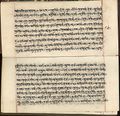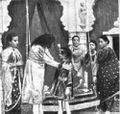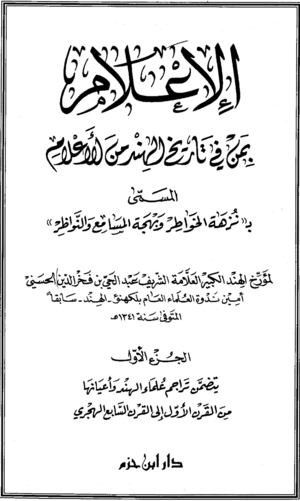ثقافة الهند
| جزء من سلسلة عن |
| ثقافة الهند |
|---|
 |
| التاريخ |
| اللغات |
| المطبخ |
| الأعياد |
| الدين |
|
|
ثقافة الهند، تشير بشكل إجمالي إلى آلاف الثقافة المتميزة والفريدة لجميع الأديان والمجتمعات الموجودة في الهند. تختلف اللغات، الديانات، الرقص، الموسيقى، العمارة، المطبخ والعادات من مكان لآخر داخل البلاد. تمتد الثقافة الهندية، التي غالباً ما توصف بأنها اندماج لعدة ثقافات، عبر شبه القارة الهندية وقد تأثرت بتاريخ يعود إلى آلاف السنين.[1][2] العديد من عناصر الثقافات الهندية المتنوعة، مثل الديانات، الفلسفة، المطبخ، اللغات، الرقص، الموسيقى والسينما الهندية لها تأثير عميق عبر الإندوسفير، الهند الكبرى والعالم.
الثقافة الدينية
الفلسفة
| |||||
التركيبة الأسرية والزواج
الزواج المرتب
|
|
|
طقوس الزواج

المهرجانات
Color drenched Gopis during the Holi celebrations in Krishna Temple, Mathura
Immersion of Ganesha idol during the Ganesh Chaturthi festival in Maharashtra
Dahi Handi, a Krishna Janmashtami festive tradition, in progress near Adi Shankaracharya Road, Mumbai, India
Durga Puja is a multi-day festival in Eastern India that features elaborate temple and stage decorations (pandals), scripture recitation, performance arts, revelry, and processions.[6]
The Hornbill Festival, Kohima, Nagaland. The festival involves colourful performances, crafts, sports, food fairs, games and ceremonies.[7]
التحيات
Right: Entrance pillar relief (Thrichittatt Maha Vishnu Temple, Kerala, India)
الحيوانات
| |||
المطبخ

الملابس
Illustration of different styles of sari, gagra choli and shalwar kameez worn by women in India
The Didarganj Yakshi depicting the dhoti wrap
Achkan sherwani and churidar (lower body) worn by Arvind Singh Mewar and his kin during a Hindu wedding in Rajasthan, India
Assamese youth in traditional festive dress. The girl is wearing mekhela sador and bindi on the centre of her forehead.
Indian actress Pakhi Hegde wearing a string-sleeve choli and sari
Indian actress Shriya Saran in woman's kameez with dupatta draped over the neck and decorative bindi on the centre of her forehead
Traditional Hajong Pathin and Argon from Northeast India
اللغات والأدب
التاريخ
|
|
الملاحم
A manuscript illustration of the Battle of Kurukshetra, fought between the Kauravas and the Pandavas, recorded in the Mahābhārata
The Battle at Lanka, Ramayana by Sahibdin. It depicts the monkey army of the protagonist Rama (top left, blue figure) fighting Ravana—the demon-king of the Lanka—to save Rama's kidnapped wife, Sita. The painting depicts multiple events in the battle against the three-headed demon general Trisiras, in the bottom left. Trisiras is beheaded by Hanuman, the monkey-companion of Rama.
Rama and Hanuman fighting Ravana from Ramavataram, an album painting on paper from Tamil Nadu, c. 1820 CE
Ilango Adigal is the author of Silappatikaram, one of the five great epics of Tamil literature.[12]
الفنون التطبيقية
الرقص
الدراما والمسرح
Kathakali one of the classical theatre forms from Kerala, India
Rasa lila theatrical performance in Manipuri dance style
Kutiyattam is one of the oldest surviving theatre traditions of the world.
Performer playing Sugriva in the Koodiyattam form of Sanskrit theatre
</ref>[13]
الموسيقى
الفنون البصرية
الرسم
The Jataka tales from Ajanta Caves
Hindu iconography shown in Pattachitra
Raja Ravi Varma’s Shakuntala (1870); oil on canvas
النحت
The 5th-century Buddhist vishvakarma cave at Ellora, Maharashtra
Marble Sculpture of female, c. 1450, Rajasthan
The Colossal trimurti at the Elephanta Caves
The iconic 57 ft high monolithic Statue of Gommateshwara, Shravanabelagola, 10th Century
العمارة
Kailasa temple is one of the largest rock-cut ancient Hindu temples located in Ellora, Maharashtra, India.
The granite tower of Brihadeeswarar Temple in Thanjavur was completed in 1010 CE by Raja Raja Chola I.
Kakatiya Kala Thoranam (Warangal Gate) built by the Kakatiya dynasty in ruins[14]
Chennakesava Temple is a model example of the Hoysala architecture.
Chaturbhuj Temple at Orchha, is noted for having one of the tallest Vimana among Hindu temples standing at 344 feet. It was the tallest structure in the Indian subcontinent from 1558 CE to 1970 CE.
Considered to be an "unrivalled architectural wonder", the Taj Mahal in Agra is a prime example of Indo-Islamic architecture. One of the world's seven wonders.[15]
Tawang Monastery in Arunachal Pradesh, was built in the 1600s and is the largest monastery in India and second largest in the world after the Potala Palace in Lhasa, Tibet.
Rumtek Monastery in Sikkim was built under the direction of Changchub Dorje, 12th Karmapa Lama in the mid-1700s.[16]
الرياضة والفنون القتالية
الرياضة
|
|
|
الفنون القتالية الهندية
| author=Thomas A. Green|url=https://books.google.com/?id=v32oHSE5t6cC&printsec=frontcover | title=Martial arts of the world: en encyclopedia. R – Z, Volume 2 | publisher=ABC-CLIO|year= 2001 | isbn=978-1-57607-150-2}}</ref>
الإعلام
التلفزيون

السينما
|
|
جوانب الثقافة الهندية

الأدب العربي في الهند

شهد شمال الهند خلال القرنين 18 و19 العديد من الأعمال الأدبية العربية البارزة فضلاً عن التعددية اللغوية. تميل التواريخ الأدبية الوطنية إلى تقسيم العالم إلى مربعات مرتبة حيث تتداخل الشعوب والأرض واللغة بشكل كامل. وفي الأقسام الأكاديمية الغربية يتم إضفاء الطابع المؤسسي على هذه الانقسامات.
لكن اللغة العربية لها تاريخ طويل وغني في جنوب آسيا من خلال مختلف منعطفات الاتصال والنشاط الزراعي المتوازي مع لغات أخرى مثل الفارسية والسنسكريتية والتاميلية والمالايالامية والأردية/اللغة الهندية|الهندية]] والسندية. لا تقتصر اللغة العربية في الهند على موضوعاً متخصصاً أو حقلاً فرعياً لكنها أكثر شمولاً.
توضح المجموعات الضخمة من المخطوطات العربية في جنوب آسيا (والمأخوذة من جنوب آسيا) مدى أهمية اللغة العربية. يعطي الاستطلاع الكبير الذي أجراه زبيد أحمد (متوافر هنا) إحساساً بمدى وانتشار تعلم اللغة العربية حتى عام 1857.
خلال فترة ما قبل الاستعمار البريطاني وما بعد الاستقلال في شمال الهند، تواجدت عدداً من المراكز الثقافية على طول نهر الگانج الممتد من لاهور (پاكستان حالياً) إلى كلكتا عبر دلهي ولكناو، لكنه يرتبط أيضاً بمدن أخرى مثل بوپال وحيدر أباد بالإضافة إلى العالم الأكثر اتساعاً للغة العربية.
سيكون من غير الصدق القول إن "العربية في جنوب آسيا" مجال مهمل. هناك الكثير من الأبحاث التي أجراها علماء في الهند وپاكستان وبنگلاديش وغالباً ما تتم كتابتها باللغة العربية أو الأردية. أضف إلى ذلك التاريخ السابق على سبيل المثال المؤلف الضخم نزهة الخواطر عبد الحين الحسيني.
اعتمد العديد من المؤرخين في جنوب آسيا على المصادر العربية ودرسوا الأعمال العربية للعلماء الأفراد وأنسابهم. وكان هناك ازدهار في الأبحاث حول الروابط والتيارات عبر المحيط الهندي والتي توضح روابط الهند مع المناطق العربية الأخرى.
انظر أيضاً
المصادر
الهوامش
- ^ John Keay (2011), India: A History, 2nd Ed – Revised and Updated, Grove Press / Harper Collins, ISBN 978-0-8021-4558-1, see Introduction and Chapters 3 through 11
- ^ Mohammada, Malika (2007), The foundations of the composite culture in India, Aakar Books, ISBN 81-89833-18-9
- ^ Ben-Ami Scharfstein (1998), A comparative history of world philosophy: from the Upanishads to Kant, Albany: State University of New York Press, pp. 9-11
- ^ Diwali 2013: Hindu Festival Of Lights Celebrated All Over The World Nadine DeNinno, International Business Times (November 02 2013)
- ^ D. Appukuttan Nair (1993). Kathakali, the Art of the Non-worldly. Marg Publications. p. 47. ISBN 978-81-85026-22-0.
- ^ James G. Lochtefeld 2002, p. 208.
- ^ "Nagaland's Hornbill Festival". Retrieved 9 December 2018.
- ^ Elizabeth Abbot (2010). Sugar: A Bittersweet History. Penguin. ISBN 978-1-590-20297-5.
- ^ Banerjee, Mukulika & Miller, Daniel (2003) The Sari. Oxford; New York: Berg ISBN 1-85973-732-3
- ^ Hobson-Jobson: The words English owes to India M.J. Campion, BBC News (11 July 2012)
- ^ Hobson-Jobson: A Glossary of Colloquial Anglo-Indian Words and Phrases Yule and Burnell (1903);
- For Anglo-Indian word database: Digital Searchable Version at University of Chicago
- See Wordnik link in: Happy Diwali The Economist (14 November 2012); Wordnik claims about 2000 English words are sourced from different Indian languages. Hobson-Jobson above lists over 2300 Indian words, as well as non-Indian words from East Asia, Persia and other regions in the British Empire that expanded English vocabulary.
- ^ Rosen, Elizabeth S. (1975). "Prince ILango Adigal, Shilappadikaram (The anklet Bracelet), translated by Alain Damelou. Review". Artibus Asiae. 37 (1/2): 148–150. doi:10.2307/3250226. JSTOR 3250226.
- ^ Mani Madhava Chakkyar: The Master at Work (film- English), Kavalam N. Panikar, Sangeet Natak Akademi, New Delhi, 1994
- ^ "The Glorious Kakatiya Temples and Gateways". UNESCO World Heritage Centre (in الإنجليزية). Retrieved 2019-03-23.
- ^ Bindloss, Joe (2007). India. Lonely Planet. ISBN 978-1-74104-308-2.
- ^ Achary Tsultsem Gyatso; Mullard, Saul & Tsewang Paljor (Transl.): A Short Biography of Four Tibetan Lamas and Their Activities in Sikkim, in: Bulletin of Tibetology Nr. 49, 2/2005, p. 57.
- ^ Centre, UNESCO World Heritage. "Rani-ki-Vav (the Queen's Stepwell) at Patan, Gujarat". whc.unesco.org (in الإنجليزية). Retrieved 2018-11-17.
- ^ James Haughton Woods (1914). The Yoga System of Pantanjali, see Book First: Concentration. Harvard University Press.
- ^ Sherri Baptiste; Megan Scott (2006). Yoga with Weights for Dummies. Wiley. ISBN 978-0-471-74937-0.
المراجع
- Ghose, Aurobindo. 1998. The foundations of Indian culture. Pondicherry: Sri Aurobindo Ashram.
- Natalia Lidova (2014). "Natyashastra". Oxford University Press. doi:10.1093/obo/9780195399318-0071.
{{cite journal}}: Cite journal requires|journal=(help); Invalid|ref=harv(help) - Natalia Lidova (1994). Drama and Ritual of Early Hinduism. Motilal Banarsidass. ISBN 978-81-208-1234-5.
- Williams, Drid (2004). "In the Shadow of Hollywood Orientalism: Authentic East Indian Dancing" (PDF). Visual Anthropology. 17 (1): 69–98. doi:10.1080/08949460490274013.
{{cite journal}}: Invalid|ref=harv(help) - Tarla Mehta (1995). Sanskrit Play Production in Ancient India. Motilal Banarsidass. ISBN 978-81-208-1057-0.
{{cite book}}: Invalid|ref=harv(help) - Emmie Te Nijenhuis (1974). Indian Music: History and Structure. BRILL Academic. ISBN 978-90-04-03978-0.
{{cite book}}: Invalid|ref=harv(help) - Gupta, S. P., & Shastri Indo-Canadian Institute. (2011). The roots of Indian art: A detailed study of the formative period of Indian art and architecture, third and second centuries B.C., Mauryan and late Mauryan. Delhi: B.R. Publishing Corporation.
- Kapila Vatsyayan (2001). Bharata, the Nāṭyaśāstra. Sahitya Akademi. ISBN 978-81-260-1220-6.
{{cite book}}: Invalid|ref=harv(help) - Kapila Vatsyayan (1977). Classical Indian dance in literature and the arts. Sangeet Natak Akademi. OCLC 233639306., Table of Contents
- Public Broadcasting System, USA (2008). The story of India – history and culture
- Sharma, Ram Sharan (2005), India's Ancient Past, (Oxford University Press, ISBN 978-0-19-568785-9).
- Bajpai, Shiva (2011). The History of India – From Ancient to Modern Times, (Himalayan Academy Publications (Hawaii, USA), ISBN 978-1-934145-38-8)
- A.L. Basham, The Wonder That was India, ISBN 0-330-43909-X, Picador London
- Auboyer, Jeannine (2002). Daily Life in Ancient India, from 200 BC to 700 AD. (originally published in French in 1961), Phoenix Press, London ISBN 1-84212-591-5
- Dalmia, Vasudha and Rashmi Sadana (editors), The Cambridge Companion to Modern Indian Culture, Cambridge University Press, ISBN 978-0-521-51625-9
- Grihault, Nicki. Culture Smart! India: A Quick Guide to Customs and Etiquette. ISBN 1-85733-305-5.
- Henderson, Carol E. (2002). Culture and Customs of India. Greenwood Publishing Group. ISBN 0-313-30513-7.
- Naipaul, V.S, India: A Million Mutinies Now, ISBN 0-7493-9920-1.
- Nilakanta Sastri, A history of South India from prehistoric times to the fall of Vijayanagar, Oxford University Press, ISBN 0-19-560686-8
- Tully, Mark. No Full Stops in India. ISBN 0-14-010480-1
- Patra, Avinash (2012), The Spiritual Life and Culture of India, Oxford University Press, England.
وصلات خارجية
- Ministry of Culture, Government of India, Links to some cultural sites and available grants for understanding the cultural diversity of India
- India and World Cultural Heritage A UNESCO site describing cultural heritage sites of India
- India's intangible cultural heritage Another UNESCO site dedicated to Indian dance and other cultural heritage












![Homes, buildings and temples are decorated with festive lights, diya, for Diwali, a major festival of India.[4]](/w/images/thumb/5/5e/Deepawali-festival.jpg/200px-Deepawali-festival.jpg)




![Kathakali performances are a part of Onam festival tradition.[5]](/w/images/thumb/4/48/Kathakali_DSC_0109_1.jpg/134px-Kathakali_DSC_0109_1.jpg)

![Durga Puja is a multi-day festival in Eastern India that features elaborate temple and stage decorations (pandals), scripture recitation, performance arts, revelry, and processions.[6]](/w/images/thumb/7/78/Durga_Puja_2015.JPG/200px-Durga_Puja_2015.JPG)
![The Hornbill Festival, Kohima, Nagaland. The festival involves colourful performances, crafts, sports, food fairs, games and ceremonies.[7]](/w/images/thumb/2/2e/Hornbil_Festival%2C_Kohima_6.jpg/200px-Hornbil_Festival%2C_Kohima_6.jpg)

















![Indian actress Priyanka Chopra wearing a lehenga and gagra choli, exposing the midriff and navel, which has long been a fashion with Indian women in popular culture[9]](/w/images/thumb/6/6e/Priyanka_on_the_ramp_for_Mijwan_fashion_show.jpg/137px-Priyanka_on_the_ramp_for_Mijwan_fashion_show.jpg)












![Ilango Adigal is the author of Silappatikaram, one of the five great epics of Tamil literature.[12]](/w/images/thumb/2/23/Puhar-ILango.jpg/133px-Puhar-ILango.jpg)

















![Kakatiya Kala Thoranam (Warangal Gate) built by the Kakatiya dynasty in ruins[14]](/w/images/thumb/3/31/Warangal_fort.jpg/124px-Warangal_fort.jpg)


![Considered to be an "unrivalled architectural wonder", the Taj Mahal in Agra is a prime example of Indo-Islamic architecture. One of the world's seven wonders.[15]](/w/images/thumb/4/4d/TajMahalbyAmalMongia.jpg/200px-TajMahalbyAmalMongia.jpg)

![Rumtek Monastery in Sikkim was built under the direction of Changchub Dorje, 12th Karmapa Lama in the mid-1700s.[16]](/w/images/thumb/e/e5/Vikramjit-Kakati-Rumtek.jpg/200px-Vikramjit-Kakati-Rumtek.jpg)













